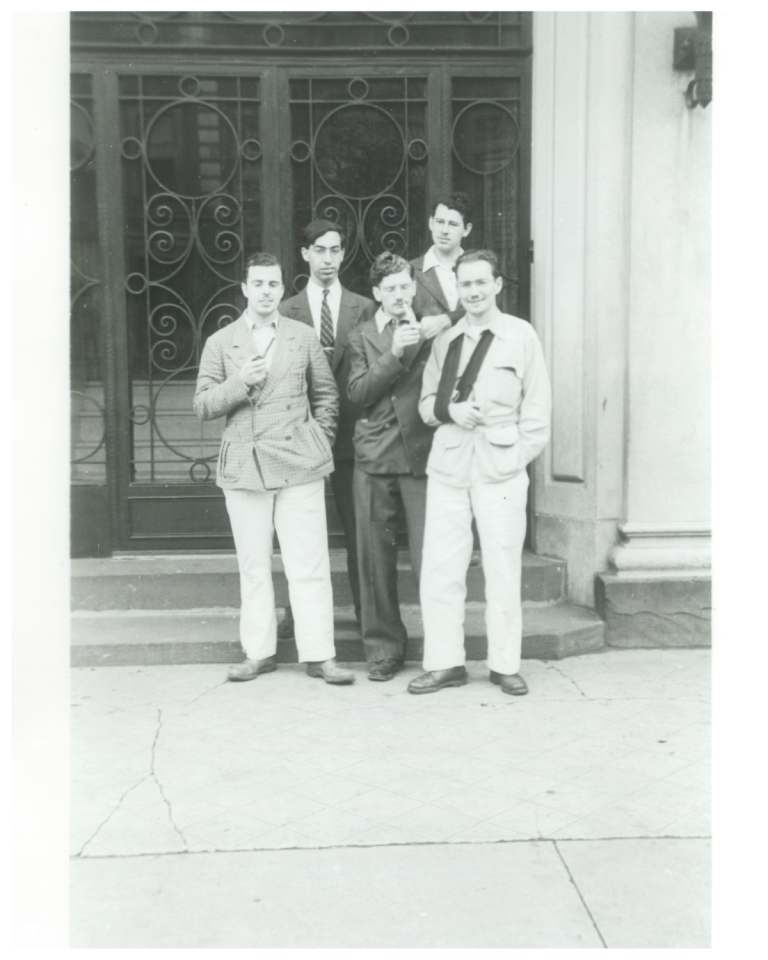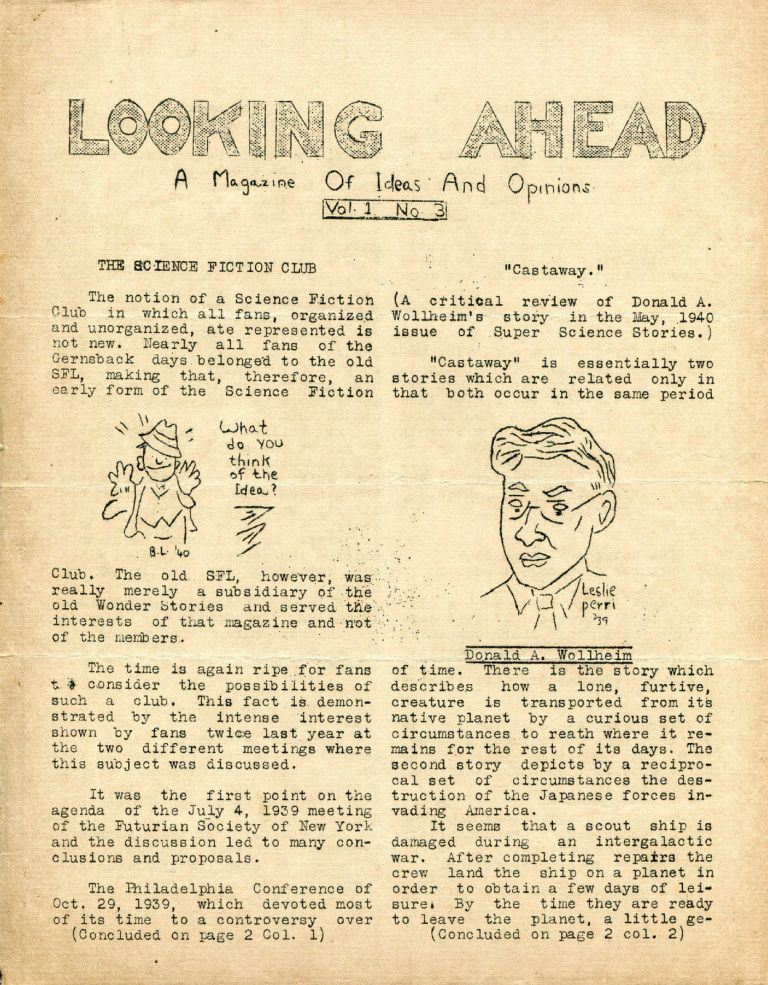By Jon D. Swartz & John L. Coker III: First Fandom original member Jack Robins passed away on December 23, 2015 after a brief illness. Robins was a science fiction (SF) fan who belonged to the International Scientific Association (ISA) in the early 1930s [invited by Walter Kubilius to attend a meeting], was a member of the famed Futurian Society of New York when it was formed in the late 1930s [inviting a former classmate of his, Isaac Asimov, to join], was part of the small group of Futurians (that included Donald Wollheim, John Michel and Fred Pohl) that organized the Committee for the Political Advancement of Science Fiction (CPASF), and he also attended the first Worldcon (Nycon) in 1939 (despite the Exclusion Act that prevented some of the other Futurians from attending).
Robins was born February 17, 1919, in Elizabeth, New Jersey. His siblings were much older, and he “was like an only child.” Born Jack Rubinson, he legally changed his name to Jack Robins. After he left the Futurians, he earned a Ph.D. in physical chemistry from The Polytechnic Institute of Brooklyn (which later merged with NYU), but he maintained an interest in SF his entire life.
In the late 1930s Robins published two issues of his fanzine The Scientific Thinker. In the early 1940s, he published ten issues of another fanzine, Looking Ahead. Later he contributed an article, “Sex in Science Fiction,” to Geep!, The Book of the National Fantasy Fan Federation (1987). In addition, he has written LoCs, articles, and reviews for fanzines, including The Fan and Tightbeam for the National Fantasy Fan Federation (N3F) and Scientifiction for First Fandom.
Jack recalled the summer of 1936:
Walter Kubilius introduced me to the ISA. These were people like me. They read and lived science fiction! They met in William Sykora’s basement and issued a mimeographed fan magazine to which I contributed. In 1937, Sykora closed his door, but the group reformed and became the Futurians. I still have fond memories of the group, and feelings of the warm comradery of those early days.
Robins has just missed being included in several important events in the history of fandom. Once, he was away when pictures of attendees at an early meeting of SF fans were taken, a meeting that became known as the First Eastern Conference. At the premier performance of the movie Things to Come, Robins left before a party that took place among fans that included Wollheim, Michel, Pohl, and James Blish. Robins was forgotten later when Wollheim wrote about those who had seen the movie and attended the party.
He missed out on other historic events because he was attending college classes, did not have enough money for required expenses, or was uncertain about dates (not having a telephone at the time). When the ISA decided to produce a movie and asked for scripts, Jack submitted one, but his was chosen as a backup in case the first choice did not work out.
Robins was a photographer who made a number of historic pictures of the Futurians.
He recalls a long walk that they all took:
Once, during the 1939 World’s Fair Days, Wollheim, Michel, Lowndes, Chester Cohen, and I decided to make a trip to Tarrytown. After taking the IRT all the way to the last stop in the Bronx, we then walked, walked, and walked, until we finally reached our destination. I had taken along a cheap 35mm camera to take pictures of all my friends, but I neglected to ask anyone to take a picture of me. We found a diner, but Lowndes and I were too poor to pay for a meal. Later, when our excursion ended, we took the train back down to the City, and then took the subway back to our homes.

(L-R) Robert W. Lowndes, Donald A. Wollheim, Chester Cohen, Cyril Kornbluth, John B. Michel. (Photograph by Jack Robins.)
Years later, when he had a subscription to Locus, Robins saw a notice by Damon Knight seeking former Futurians. Knight wanted documents related to the famous SF fan club for the tell-all book he was writing. Robins sent him what he had, but all Knight used in his 1977 book, The Futurians, was a couple of pictures that Robins had taken.
In his 1983 book relating his memories of SF’s Golden Age, The Way the Future Was, Frederik Pohl barely mentioned Robins. Later, in commenting on Robins’ activities as a Futurian, Pohl referred to him as “the smiling guy in the background.” Another time – after acknowledging that Robins had been a Futurian from the beginning — he described him as more of an auditor than a participant.
One of the reasons for his exclusion from some Futurian activities probably was the fact that Robins was a “science man” and was not a would-be writer. Although he wrote some fan plays, he went on to earn three college degrees and became a research chemist with a doctorate. Most of the Futurians aspired to be professional SF writers and editors, not professional scientists. Another “science man” was Asimov, who had gone to Boys High School with Robins.
In 1984, Robins retired from his job with the Atlas Powder Company in Tamaqua, Pennsylvania, where he had worked for twenty-five years as a research chemist. Over the ensuing years Jack wrote family histories, convention reports, articles, poetry, sonnets, and plays, including a tribute to the Futurians, entitled “The Ivory Tower.” In retirement Jack was busier than ever, writing a column of non-fiction articles for his condo newspaper and working on his memoirs. In addition, he was at one time co-president of the computer club at his condo and the person in charge of publicity.
Robins was optimistic: “The world is full of wonder to me. Many scientists developed their interest in science after reading science fiction and some inventors attribute their creations to their knowledge of science fiction. I see the influence of STF everywhere.”
Jack was happily married for sixty-six years to Lottie, the love of his life. They shared an interest in photography and Classical music. They adored each other and enjoyed the daily company of family and friends. Then, after a brief illness, Jack passed away.
Jack Robins was inducted into the First Fandom Hall of Fame and made a N3F Life Member, both in 2012. He was a life-long genuine enthusiast who knew many of the early fans and was present as history was unfolding. Jack pursued his dream of going to college and becoming a real scientist. His written accounts and photographs have become an important part of the record of the early days of science fiction fandom.
Discover more from File 770
Subscribe to get the latest posts sent to your email.






I believe this leaves as sole survivors of that era just Bob Madle and Dave Kyle.
Bob is still selling books. Printed catalog only.
And Dave still goes to the occasional convention.
The January-Febuary 2016 issue of Robert Jennings’s fanzine Fadeaway has an article by Jack Robins about his life in fandom. How ironic.
I believe that Mel Korshak was also at the NyCon. Which means there are now only three attendees left. And Kyle is the last of all the Futurians.
One of Jack Robins’ last fannish acts was to complete an extended article on the Futurians for The National Fantasy Fan, newsletter of the National Fantasy Fan Federation. It was a response to a prior article on the Futurians, an article that first appeared in Fadeaway, which I then reprinted with permission in TNFF. I then shared Robins’ article — we are still running parts of it in future issues of TNFF — with Bob Jennings and his fine fanzine, where you can also see it. [TNFF is free with free N3F public membership, available at http://N3F.org].